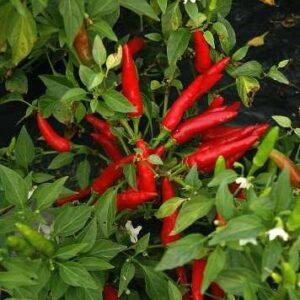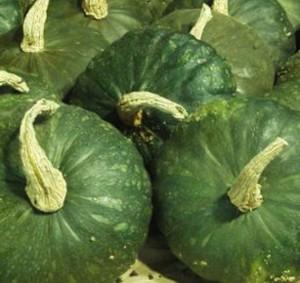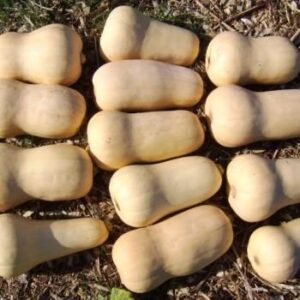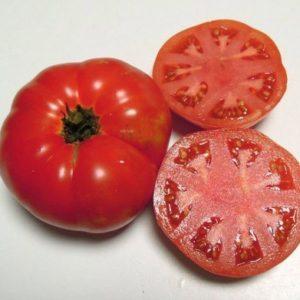For the Best Results in Organic Systems, Grow Varieties Bred for Organic Systems.
(By Carol Deppe)
Feature Photo: ‘Santiam Sunrise’ tomato. Photo: Adaptive Seeds.
(Based upon an article that ran originally in the January 2017 issue of Acres/USA, a primary magazine for organic farmers.)
We organic gardeners and farmers frequently find that our needs are not well-served by the agribusiness seed industry. Nearly all the varieties it produces are bred for use in chemical agriculture. These varieties are bred for optimal performance when fed with high doses of soluble fertilizers. The plants often have wimpy root systems incapable of forming alliances with beneficial microbes or scrounging nutrients from natural soils or under low-input management regimes. They may need the use of fungicides or pesticides. And agribusiness varieties are often adapted for optimal production only in high-density monocultures managed with herbicides. In addition, more attention is often paid to yield than to quality, and to configuring the genes and marketing arrangements so as to create a monopoly over seed production. For optimal performance in organic systems, we need varieties that are bred on organic soils and intended for use in organic systems.
Where can we go to find bred-for-organics varieties? The Open Source Seed Initiative (OSSI) now has the most extensive list of bred-for-organics varieties in the world. Many of OSSI’s variety contributors are independent plant breeders whose interest in plant breeding was sparked initially by the dearth of organic-adapted varieties. About 90% of the over 300 OSSI-Pledged varieties were bred specifically for organics. For a comprehensive list of these varieties go to http://osseeds.org/, click on the Seed page, and check the category “Bred for organic systems.” You will find a list of 260 bred-for-organics varieties, complete with descriptions, photos, and links to the associated OSSI Partner Seed Companies where you can buy the seed.
About Open Source Seed Initiative (OSSI)
Multinational seed companies continue to consolidate their control over the supply of food crop seed. Many new vegetable varieties (especially lettuces) are now being patented. If we buy such seed, we cannot legally save seed from our harvest, not even just for our own use for replanting. Nor are we allowed to use a patented variety to breed anything new of our own without the permission of the patent holder. Practically speaking, we don’t own such seed at all. We are just renting use of it for a season. Worst of all, seed company variety descriptions and seed packets often don’t tell us about the patents. Increasingly, when we “buy” seed, we actually have no idea of what we are and aren’t buying and what we can and cannot do with it.
 The Open Source Seed Initiative is where the fight to take back control of our seed is happening. OSSI does this via its Pledge and its collection of OSSI-Pledged varieties. The heart of OSSI is the Pledge. The Pledge is first signed by the breeder of a variety, and is henceforth always transmitted along with seed of the variety. The Pledge reads: You have the freedom to use these OSSI-Pledged seeds in any way you choose. In return, you pledge not to restrict others’ use of these seeds or their derivatives by patents or other means, and to include this Pledge with any transfer of these seeds or their derivatives.
The Open Source Seed Initiative is where the fight to take back control of our seed is happening. OSSI does this via its Pledge and its collection of OSSI-Pledged varieties. The heart of OSSI is the Pledge. The Pledge is first signed by the breeder of a variety, and is henceforth always transmitted along with seed of the variety. The Pledge reads: You have the freedom to use these OSSI-Pledged seeds in any way you choose. In return, you pledge not to restrict others’ use of these seeds or their derivatives by patents or other means, and to include this Pledge with any transfer of these seeds or their derivatives.
The Pledge has a viral component. Any new variety developed by using an OSSI-Pledged variety as a parent is also covered by the Pledge. Thus OSSI seeks to create an ever expanding but protected commons of genes, plant traits, and varieties—a commons open only to others who are willing to share.
The first component of the OSSI community are the 36 plant breeders who cooperate with OSSI by OSSI-Pledging their varieties, and by doing so declare their intention that their varieties be accessible to all gardeners, farmers, and communities, now and into the future. The second part of the OSSI Community is the 46 cooperating Seed Partners. These seed companies sell OSSI-Pledged varieties, identify those varieties in their catalogs by using the OSSI logo or the words “OSSI” or “OSSI-Pledged,” pass the Pledge along with the seed, and so help create a new pattern for control of seed.
The third part of the OSSI community is you. Do you want to buy seed you can fully own, that you can save seed from, that you can use to develop new varieties of your own, varieties that express your own creativity, requirements, and preferences? Do you want varieties that reflect the values and needs of organic gardeners and farmers rather than just those of multinational seed companies—seed companies many of which are also the major producers of pesticides and herbicides? If so, go to the http://osseeds.org/ website and check out the photos and descriptions of its 260 bred-for-organics OSSI-Pledged varieties. Sign up for the OSSI Newsletter, Free the Seed. And buy from and support the OSSI Seed Company Partners.
Meanwhile, to whet your appetite, here are a few highlights from OSSI’s list. Included in some of the descriptions are a few hints and tips as to how the varieties were bred, to inspire you to consider developing some bred-for-organics, open source varieties of your own.
Thirty-three Open Source, Open Pollinated, Bred-for-Organics, OSSI-Pledged Varieties
Beet: ‘Sweet Dakota Bliss’. (Bred by David Podoll, Prairie Road Organic Seed.) A fast-growing deep burgundy beet good for both roots and greens. Beets are uniform, smooth-skinned, and keep well in a root cellar.

Broccoli (Brassica oleracea): ‘Solstice’. (Bred by Jonathan Spero, Lupine Knoll Farm.) Very early open-pollinated broccoli with blue-green heads 3 – 5 inches in diameter followed by lots of side shoots. Heads are everted, that is, they project up above the foliage for easy cutting. Jonathan bred ‘Solstice’ by six generations of selection from heterogeneous material with the everted-head trait he obtained from a collaborative project between Oregon State University Horticulture Department and cooperating farmers. ‘Solstice’ may be the earliest broccoli. Jonathan starts seeds in flats late in March, transplants, and has heads by June 21, weeks earlier than most other broccolis. For an early spring crop or a late fall crop. (Use something else for main-season harvests.
Corn—Sugary Enhanced (en): ‘Festivity’. (Bred by Jonathan Spero, Lupine Knoll Farm.) Here is a beautiful multicolored sugary enhanced open-pollinated sweet corn with excellent flavor, long-holding on and off the plant, and attractive 10 – 16 row, 8-inch ears that show pastel versions of their colors at the sweet eating stage. Jonathan bred ‘Festivity’ by selecting for six generations from crosses of ‘Anasazi’, a native American multicolored traditional sweet corn, and ‘Tuxedo F1’, a hybrid yellow sugary enhanced variety. ‘Festivity’ has been selected for direct seeding, and has excellent cold soil emergence.
Corn—Sugary Enhanced (en): ‘Top Hat’. (Bred by Jonathan Spero, Lupine Knoll Farm.) Mid-season sugary-enhanced yellow sweet corn with rich flavor raw and cooked. It has excellent husk coverage, a great help in minimizing damage from birds and ear worms. ‘Top Hat’ has 7 ½ inch ears with 16 rows of deep tender kernels. A dehybridization of ‘Tuxedo F1’. Selected for direct seeding, it has excellent cold-soil emergence.
Corn—Sugary Enhanced (en): ‘Tuxana’. (Bred by Jonathan Spero, Lupine Knoll Farm.) Late season white sugary enhanced sweet corn with rich sweet flavor both raw and cooked. Ears are about 9 inches long, with 14 – 16 rows. Plants are about 6 ½ feet tall. Large ears with deep kernels makes for a corn great for cutting kernels off the ears for creamed corn, or for freezing or drying (in addition to eating fresh). Bred by six years of selection from crosses of ‘Anasazi’ and ‘Tuxedo F1’. Bred for direct seeding, and has excellent cold-soil emergence.
Corn—Supersweet (sh2): ‘New Mama Super Sweet’. (Bred by Andrew Still, Adaptive Seeds.) One of the few open-pollinated supersweet corns. It’s a very sweet corn with yellow medium sized ears. Andrew developed it by selecting and stabilizing from crosses of ‘White Sugar’ (a supersweet bred by Tim Peters) and yellow supersweet material provided by Friedemann Ebiner of Sativa Rheinau (Switzerland). Andrew recommends starting ‘New Mama Super Sweet’ from transplants, as is usually done with supersweet corns in the Northwest.

Corn—Popcorn: ‘Dakota Black Pop’. (Bred by David Podoll, Prairie Road Organic Seed.) Relatively early for a popcorn, in spite of having bigger ears and being more productive than most popcorns. Plants are 4 – 6 feet high. There is usually one 5 – 8 inch ear per plant. Deep black kernels pop into white popcorn with a unique, distinctive, delicious flavor.
Lettuce: ‘Blushed Butter Cos’. (Bred by Frank Morton, Wild Garden Seed.) Philomath High School student approved variety. What recommendation could be better? Sweet, buttery, savoyed, folded leaves on butterhead-cos heads.
Lettuce: ‘Hyper Red Rumple Waved’. (Bred by Frank Morton, Wild Garden Seed.) Spectacularly deep purple-red savoyed, folded, puckered leaves on semi-cos heads. Gorgeous. Highly resistant to Sclerotinia and downy mildew.
Lettuce: ‘Joker’. (Bred by Frank Morton, Wild Garden Seed.) Head lettuce with deeply savoyed green with red speckled leaves. Great flavor and crisp texture. An all-season variety; excellent heat and cold resistance. Survives to 20° F unprotected.
Lettuce: ‘Outredgeous’. (Bred by Frank Morton, Wild Garden Seed.) Very red lettuce with a loose-leaf romaine head. Already a classic. First lettuce to be grown and eaten in outer space, chosen in part for its fast growth and vigor.

Muskmelon: ‘Dakota Sisters’. (Bred by David Podoll, Prairie Road Organic Seed). Short-season melon bred for great flavor, smooth texture, and thick, deep-orange flesh.
Onion: ‘Dakota Tears’. (Bred by David Podoll, Prairie Road Organic Seed.) Open-pollinated 12-ounce onion with serious onion flavor. Yellow flesh, medium-wide necks, vigorous, and long-storing.
Pepper: ‘Matchbox’. (Bred by Roberta Bailey, Fedco Seeds/Seven Tree Farm.) Squat prolific plants produce copious numbers of upright 2-inch long peppers that ripen from pale green to deep scarlet. Plenty of fire. Widely adapted and resilient. Can handle cold/wet or hot/dry, and any kind of soil. Can be potted and overwintered.
Spinach: ‘Abundant Bloomsdale’. (Bred by Organic Seed Alliance and cooperating organic farmers.) Thick, broad, succulent, sweet dark-green leaves. Highly savoyed. Upright plant form keeps leaves out of the mud. Best for spring and fall plantings. Can overwinter in the maritime Northwest.
Spinach: ‘Beaujolais’. (Bred by Brian Campbell, Uprising Seeds). Green-leaved spinach with magenta-red veins. Bred for the baby leaf stage. (Like most red spinach, it bolts too early to use for bunching.)
Spinach: ‘Popeye’. (Bred by Don Tipping, Siskiyou Seeds.) Vigorous 40-day spinach with savoyed, arrow-shaped leaves. Late bolting.

Squash, Summer (Cucurbita pepo): ‘Goldini Zucchini’. (Bred by Carol Deppe, Fertile Valley Seeds.) Gold slightly ridged fruits with delicious flavor and crunchy texture raw, and wonderful flavor cooked or dried. Bred for dual use for cooking or drying; great flavor raw was a happy accident. Prime flavor at unusually large range of sizes—up to 2 pounds for use raw or cooked—allows greater flexibility in harvest and dramatically higher total productivity. Prime size for drying is up to 4 pounds. So when the squash “escape” you, just slice and dry them for a long storing staple. (Dry slices in a dehydrator at 95° F. For dipping chips make slices ¼ inch thick. For use in long-cooking soups or stews, make slices 1/2 inch thick. For slivers that rehydrate in a few minutes in a soup or stew, shoot squash through a salad shooter onto dehydrator sheets. For more on drying squash at the summer squash stage, see The Resilient Gardener.) I also bred ‘Goldini Zucchini’ to be the fastest germinating and growing squash on the planet. (It’s stabilized from a cross of ‘Costata Romanesco’ and an F2 plant from ‘Gold Rush F1’.) I selected ‘Goldini Zucchini’ for uniformity only in the characteristics that matter. The plants are all vigorous bushes. The pedicles (fruit stems) may be green or gold. The leaves are all different shapes, sizes, and colors. I deliberately maintain all this vigor-enhancing heterogeneity in the variety. If you are fanatic about uniformity for things that don’t matter, grow something else.
Squash, Winter (Cucurbita maxima): ‘SunDream’. (Bred by Don Tipping, Siskiyou Seeds.) Don bred ‘SunDream’ by dehybridizing from ‘Sunshine F1’. He simply self-pollinated the hybrid and grew out the F2 generation. The plants all had orange fruit of about the same size as ‘Sunshine F1’, and they all tasted great. The only obvious segregation was for the bush characteristic. Don selected for the vine type plants, and began selling seed as of the F3 seed crop. He’s up to the F5 now. (If the two parent lines that went into the hybrid are closely related, we may not see much variability in the F2, and dehybridizing may be fast and easy.)
Squash, Winter (Cucurbita maxima): ‘Uncle David’s Dakota Dessert’. (Bred by David Podoll, Prairie Road Organic Seed). A large, rich-flavored, emerald-green buttercup that is rapidly winning a devoted following. Widely adapted and resilient.

Squash, Winter (Cucurbita moschata): ‘Bigger Better Butternut’. (Bred by Carol Deppe, Fertile Valley Seeds). Early 5 – 12 pound butternut with long thick necks. Matures reliably in Willamette Valley Oregon in spite of its large size. Very long storing, even when stacked in piles like logs. I bred ‘Bigger Better Butternut’ by dehybridizing from ‘Ultra Butternut HP F1’. (I like big butternuts. I can slice off a round from the neck for use in a one-person portion of soup or stew. Then I smear the resin that leaches out of the cut over the end to seal it. The rest of the fruit will then store for several days at room temperature without drying out or molding. So each day or few days, I just cut off what I need. Bigger butternuts are more efficient to harvest, store, and prepare. And they have a much lower proportion of waste than smaller fruits.)
Squash, Winter (Cucurbita moschata): ‘Early Butternut Remix’. (Bred by Andrew Still, Adaptive Seeds.) A very early 2 – 4 pound butternut. Andrew bred it by first growing together every early butternut variety he could find, including ‘Nutterbutter F1’, ‘Early butternut F1’, ‘Hunter F1’, ‘Butterfly F1’, and others. He allowed them to intercross freely, then saved and replanted the seed for several generations, each generation selecting for small fruits with the classic butternut shape. The current generation of seed is the F6.
Swiss Chard: ‘Prismatic Rainbow’. (Bred by Don Tipping, Siskiyou Seeds.) Upright growth and dark green leaves with irridescent pink or white (mostly pink) veins. Chosen for the Fedco list based upon its unique flavor—“sweet and crisp…utterly devoid of that oxalic chard bite.”
Tomato (Determinate): ‘Orange You Glad’. (Bred by Andrew Still, Adaptive Seeds.) “Orange You Glad it’s easier to raise tomatoes than children?” says the Adaptive Seeds catalog. “Orange You Glad we dehybridized ‘Orange Blossom’ so you can save seed from it too?” ‘Orange You Glad’ is an early, high-yielding variety that produces medium size orange tomatoes on determinate bushes. Andrew simply saved seed from ‘Orange Blossom F1’. He didn’t see much in the way of segregation in the putative F2 plants. Just a little variability for fruit size and plant vigor. He kept seed from the best plants and continued planting it. He’s up to the F5 at this point. Sometimes hybrids represent crosses between closely related varieties or varieties that are similar or identical for all the obvious visually apparent traits. In these cases one may see no obvious segregation, and practically speaking, may have a new useful variety in just a year or two, with all or almost all the plants resembling the hybrid parent right from the beginning. In some cases the seed company that sold the commercial “hybrid” may have fibbed about the variety being a hybrid in the first place to scare people away from saving the seed. Either way, as Andrew says, “Sometimes plant breeding is easy!”
[gdlr_styled_box content_color=”#ffffff” background_color=”#3d6817″ corner_color=”#9ada55″ ]
Dwarf Tomato Varieties
Dwarf tomato plants have stocky stems, rugose foliage, and heights of 2 to 4 ½ feet, depending upon variety. They are ideal for growing in 5-gallon pots or indoors or on balconies. Plants are usually staked to support the heavy fruit load. Unlike determinate tomato varieties, dwarfs are indeterminate, but just very stocky, compact indeterminates. Dwarf tomato plants have a better ratio of leaves to fruit than determinate varieties, and are capable of producing full-flavored tomatoes on their small plants. Until recently, however, dwarf varieties generally had only small fruits. In 2005, Craig LeHoullier and Patrina Nuske-Small decided to change that. They put together a team of more than 200 tomato-loving gardeners and started an all-volunteer, two-continent-wide project to develop dozens of new dwarf tomato varieties with myriad tomato colors, flavors, and sizes. For more information about the Dwarf Tomato Project, see http://dwarftomatoproject.net/ and http://www.craiglehoullier.com/dwarf-tomato-breeding-project/.[/gdlr_styled_box]
[gdlr_styled_box content_color=”#000000″ background_type=”image” background_image=”YOUR_IMAGE_URL” ][/gdlr_styled_box]

Tomato (Dwarf): ‘Adelaide Festival’. (Bred by Patrina Nuske-Small, Dwarf Tomato Project). 8 – 10 ounce purple tomatoes with green stripes; ripen to olive and gold. Juicy and delicious. Plants to 3 feet.
Tomato (Dwarf): ‘Dwarf Orange Cream’. (Bred by Patrina Nuske-Small, Dwarf Tomato Project). 8 – 12 ounce pale orange fruits with intense delicious flavor and “lively tang.” Said to be among the best-flavored dwarfs. Plants to 4 feet.
Tomato (Dwarf): ‘Loxton Lass’. (Bred by Patrina Nuske-Small, Dwarf Tomato Project). 7 – 10 ounce bright orange, sweet juicy fruit. Plants to 4 feet.

Tomato (Dwarf): ‘Maralinga’. (Bred by Patrina Nuske-Small, Dwarf Tomato Project). 6 – 10 ounce rich brown tomatoes with purple-red interiors. Meaty. Plants to 4 feet.
Tomato (Dwarf): ‘Uluru Ochre’. (Bred by Patrina Nuske-Small, Dwarf Tomato Project). Very early. 8 – 16 ounce orange-green-ochre tomatoes with rich sweet smoky flavor. Plants to 4 feet.
Tomato (Dwarf): ‘Waratah’. (Bred by Patrina Nuske-Small, Dwarf Tomato Project). Medium-early. 6 – 12 ounce red tomatoes with amazing sweet, fruity flavor. Plants to 4 feet.
Tomato (Indeterminate): ‘Perfect Rogue’. (Bred by Andrew Still, Adaptive Seeds.) Andrew recommends this early, medium-sized red tomato as an open-pollinated substitute for ‘Early Girl F1’. The main plant breeding method Andrew used was alert opportunism. He was growing a row of hybrid Early Girls for market when four plants appeared with potato leaves instead of ordinary leaves and slightly smaller fruit. The four rogues may represent the sorting out of a new mutation. But it’s also possible that they represent one of the inbred parent varieties that went into making the hybrid. (Sometimes things go wrong in hybrid seed production, and some self-pollinations from the maternal parent find their way into the seed crop.) Andrew saved seed of the rogues, grew out that seed, and saved seeds from the best plants for a number of years. There wasn’t much obvious segregation or variability in the plants. He just saved the seed from the best most productive plants each year to further adapt the material to his region. Another case of plant breeding being easy.
Tomato (Indeterminate): ‘Santiam Sunrise’. (Bred by Andrew Still, Adaptive Seeds.) This is Andrew’s attempt at producing an open pollinated substitute for ‘Sungold F1’ cherry tomato. ‘Santiam Sunrise’ is a little sweeter and a little less fruity than ‘Sungold’. It includes parentage from ‘Sungold F1’ as well as ‘Katika’, an open-pollinated orange cherry tomato. At this point, it is more than 99% pure for the orange color. Flavor is a bit different from, but as good or better than that of ‘Sungold F1’. And unlike ‘Sungold F1’, ‘Santiam Sunrise’ is highly resistant to cracking or splitting. (Andrew actually started his quest for an open-pollinated Sungold substitute by just trying to dehybridize ‘Sungold F1’. But by the time he was up to an F4, he had figured out that the gold fruit color and great flavor went together, and were always heterozygous. That is, orange-fruited plants always continued to segregate 1:2:1 for red, orange, and yellow. We can often dehybridize a hybrid, but not always. Andrew got around the problem by crossing his Sungold material to another orange cherry variety, one capable of being pure-breeding for orange, and selecting from there. A case of plant breeding being tricky. (See feature photo at beginning of this article.)
Watermelon: ‘Sweet Dakota Rose’. (Bred by David Podoll, Prairie Road Organic Seed). This 15 – 20 pound watermelon is one of the sweetest of open-pollinated varieties, and has small numbers of small seeds. It’s winning increasing acclaim for its flavor as well as for being the only really big watermelon that will produce and taste great in New England.
There they are. Thirty-three open-pollinated, bred-for-organics, OSSI-Pledged vegetable varieties. To find the sources and links for these and another 200+ such varieties, to learn more about the Open Source Seed Initiative, and to sign up for the OSSI newsletter Free the Seed!, visit http://osseeds.org/.
RESOURCES
SEEDS: Go to the OSSI website Seed page for descriptions, photos, and OSSI Seed Partner sources for seed of all OSSI-Pledged varieties: http://osseeds.org/seeds/
BOOKS:
Deppe, Carol. Breed Your Own Vegetable Varieties: The Gardener’s and Farmer’s Guide to Plant Breeding and Seed Saving 2nd ed. (Chelsea Green, 2000).
Deppe, Carol. The Resilient Gardener: Food Production and Self-Reliance in Uncertain Times (Chelsea Green, 2010). (Includes breeding, use, and recipes for a number of corn, bean, and squash varieties.)
Deppe, Carol. The Tao of Vegetable Gardening: Cultivating Greens, Peas, Beans, Squash, Joy, and Serenity (Chelsea Green 2015). (Includes sections on breeding for organic systems, rejuvenating heirloom varieties, dehybridizing hybrids, and tomato genetics and breeding.)
Kloppenburg, Jack. First the Seed: The Political Economy of Plant Biotechnology, 1492-2000 (2nd ed.), (University of Wisconsin Press, 2005). (The definitive book on control of seed in U.S.A., by Jack Kloppenburg, Professor Emeritus of Community and Environmental Sociology, University of Wisconsin-Madison. Jack is one of the founders of OSSI and a member of the board of directors.
WEBSITES:
Carol Deppe (books, articles, and seeds): http://www.caroldeppe.com/
Dwarf Tomato Project:
http://dwarftomatoproject.net/
http://www.craiglehoullier.com/dwarf-tomato-breeding-project/
 Oregon plant breeder Carol Deppe focuses on breeding open source crops for organic systems, superior flavor and nutrition, and human survival for the next thousand years. She is a member of the OSSI Board of Directors. She is owner of Fertile Valley Seeds and author of Breed Your Own Vegetable Varieties: The Gardener’s and Farmer’s Guide to Plant Breeding and Seed Saving; The Resilient Gardener: Food Production and Self-Reliance in Uncertain Times; and The Tao of Vegetable Gardening: Cultivating Tomatoes, Greens, Peas, Beans, Squash, Joy, and Serenity. For books, articles, and seeds, visit www.caroldeppe.com.
Oregon plant breeder Carol Deppe focuses on breeding open source crops for organic systems, superior flavor and nutrition, and human survival for the next thousand years. She is a member of the OSSI Board of Directors. She is owner of Fertile Valley Seeds and author of Breed Your Own Vegetable Varieties: The Gardener’s and Farmer’s Guide to Plant Breeding and Seed Saving; The Resilient Gardener: Food Production and Self-Reliance in Uncertain Times; and The Tao of Vegetable Gardening: Cultivating Tomatoes, Greens, Peas, Beans, Squash, Joy, and Serenity. For books, articles, and seeds, visit www.caroldeppe.com.


























